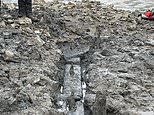
Known as the gateway to Wales, Chepstow is a border town steeped in history.
It boasts a 12th-century Norman castle overlooking the River Wye but was seen as a strategic stronghold long before those battle lines were drawn.
That’s because archaeologists have previously uncovered evidence of prehistoric, Roman and Anglo-Saxon fortifications — and now something else.
It turns out the town was once home to an ancient bridge that linked England and Wales before the two countries came to be.
This wooden structure – believed to have been built by the Romans 2,000 years ago – was found preserved in mud following a race against time to uncover it during an ‘extreme low tide event’.
An ancient bridge – believed to have been built by the Romans 2,000 years ago – was found preserved in mud in the River Wye near Chepstow
Archaeologists had just a two-hour window to dig it out and had to be assisted by specialist rescue teams because of the perilous nature of their task
WHERE DOES THE BRIDGE LINK FROM AND TO?
The ancient crossing links a route between Wales and England from around half a mile upstream of Chepstow to the village of Tutshill in Gloucestershire.
The bridge was previously discovered and partially excavated in 1911 by Dr Orville Owen.
It also appeared on an old Ordnance Survey map at around the same time but has been buried in mud ever since.
Archaeologists think it is 2,000 years old and dates back to the Roman times.
Samples were taken from the timbers, which will now undergo carbon dating to determine the bridge’s exact age.
Archaeologists had just a two-hour window to dig it out and had to be assisted by specialist rescue teams because of the perilous nature of their task.
The ancient crossing links a route between Wales and England from around half a mile upstream of Chepstow to the village of Tutshill in Gloucestershire.
Simon Maddison, of the Chepstow Archaeological Society (CAS), said: ‘The team were able to locate upright timbers in a tidal pool on the location of the Roman crossing.
‘Until the results come back we won’t know for sure the period of the structure.
‘We are thrilled with what we were able to achieve and await dating results with keen anticipation.’
Experts from CAS were given assistance by members of the Severn Area Rescue Association (SARA), who helped some of the team down off the bank using mud stretchers taken to the site by boat.
Mr Maddison said: ‘The mud was very dense and very sticky, and we frequently got stuck in it. Without SARA it would have been impossibly dangerous.’
Samples were taken from the timbers, which will now undergo carbon dating to determine the bridge’s exact age
The ancient crossing links a route between Wales and England from around half a mile upstream of Chepstow to the village of Tutshill in Gloucestershire
Experts from CAS were given assistance by members of the Severn Area Rescue Association (SARA), who helped some of the team down off the bank using mud stretchers taken to the site by boat
The bridge was previously discovered and partially excavated in 1911 by Dr Orville Owen. It also appeared on an old Ordnance Survey map at around the same time but has been buried in mud ever since
SARA Beachley posted photos of the muddy dig, saying: ‘Something different last Friday! A small SARA team provided safety cover and other muddy assistance to a group from the Chepstow Archaeological Society, investigating the site of the Roman bridge across the Wye just above Chepstow Castle.
‘With amazing results, as these photos show!
‘This was our second such outing, and followed a visit in May which was something of a detailed reconnaissance.’
They added: ‘Both visits were arranged for the bottom of spring tides, to give the maximum exposure of the area.
‘And this meant that both outings provided a lot of good training value for us, with boat handling in shallow and pretty fast moving water as well as operating in the mud, as well as helping with the archaeology.’
Simon Maddison, of the Chepstow Archaeological Society (CAS), said: ‘The team were able to locate upright timbers in a tidal pool on the location of the Roman crossing’
He added that ‘until the results come back we won’t know for sure the period of the structure’
‘We are thrilled with what we were able to achieve and await dating results with keen anticipation,’ Mr Maddison said
Known as the gateway to Wales, Chepstow is a border town steeped in history. It boasts a 12th-century Norman castle overlooking the River Wye but was seen as a strategic stronghold long before those battle lines were drawn
The bridge was previously discovered and partially excavated in 1911 by Dr Orville Owen.
It also appeared on an old Ordnance Survey map at around the same time but has been buried in mud ever since.
‘It was recorded but we did not know exactly where it was,’ Mr Maddison said.
‘Detective work on the drawings in Chepstow Museum enabled us to pinpoint its likely location and this proved to be correct.’
Another bridge, called The Old Wye Bridge, was later built close to the 950-year-old Chepstow Castle.
This was constructed in 1816 using cast iron and stone in 1816 and has been designated as a Grade I listed building.
How England spent almost half a millennium under Roman rule
55BC – Julius Caesar crossed the channel with around 10,000 soldiers. They landed at a Pegwell Bay on the Isle of Thanet and were met by a force of Britons. Caesar was forced to withdraw.
54BC – Caesar crossed the channel again in his second attempt to conquer Britain. He came with with 27,000 infantry and cavalry and landed at Deal but were unopposed. They marched inland and after hard battles they defeated the Britons and key tribal leaders surrendered.
However, later that year, Caesar was forced to return to Gaul to deal with problems there and the Romans left.
54BC – 43BC – Although there were no Romans present in Britain during these years, their influence increased due to trade links.
43AD – A Roman force of 40,000 led by Aulus Plautius landed in Kent and took the south east. The emperor Claudius appointed Plautius as Governor of Britain and returned to Rome.
47AD – Londinium (London) was founded and Britain was declared part of the Roman empire. Networks of roads were built across the country.
50AD – Romans arrived in the southwest and made their mark in the form of a wooden fort on a hill near the river Exe. A town was created at the site of the fort decades later and names Isca.
When Romans let and Saxons ruled, all ex-Roman towns were called a ‘ceaster’. this was called ‘Exe ceaster’ and a merger of this eventually gave rise to Exeter.
75 – 77AD – Romans defeated the last resistant tribes, making all Britain Roman. Many Britons started adopting Roman customs and law.
122AD – Emperor Hadrian ordered that a wall be built between England and Scotland to keep Scottish tribes out.
312AD – Emperor Constantine made Christianity legal throughout the Roman empire.
228AD – The Romans were being attacked by barbarian tribes and soldiers stationed in the country started to be recalled to Rome.
410AD – All Romans were recalled to Rome and Emperor Honorious told Britons they no longer had a connection to Rome.
Source: History on the net
Source link
CHECK OUT: Top Travel Destinations
READ MORE: Travel News



